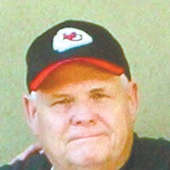Fences and creeks
As I write this story, Missouri is fast approaching the end of its second full week of quail hunting. In the 17 years of writing this weekly column, stories about this challenging game bird, head up my most often used topic list.
I awoke early Friday the 13th. When I looked at the weather app on my iPhone, the temperature outside was a brisk 28 degrees. My immediate reaction was to acknowledge, this would be a great day to go quail hunting.
During a hunt in Vernon County, weather impacts the hunters, the bird dogs, and the quail. None of the three participants work well if the temperature is much above the freezing level.
Quail have some unique patterns and behaviors, unlike just about any other game bird. They are by nature social. The term used to describe a packed gathering of quail is called a "covey." The dictionary defines the word covey as ... a brood or small flock of birds."
Quail love to huddle together in a covey for protection. They have many other predators besides man. They only move from the covey to feed on natural wild food items such as grass seeds. They tend to pack more tightly, when the weather is cold, which gives them collective warmth.
The dogs that quail hunters use to locate quail, have eons of hunting genes built into their bodies. Their single most effective hunting skill is their ultra sensitive sense of smell. In warm, dry weather, dust and pollen inhibit this ability significantly.
During hunting season, if the temperature drops well below freezing, the dog's ability to locate this elusive bird is greatly enhanced. An increase in moisture level offers prime conditions.
When I was a kid hunting with my grandfather and father, the best quail hunting days were those that included a light covering of snow. I can see the pictures in my mind still. Everywhere there were countless tracks in the snow covering, from a variety of animals. Rabbits were found in much larger numbers back then, and their tracks dominated the surface. Our dogs were well trained, so that they would not be distracted by the scents of rabbits and other small game animals.
On the land where I was raised, there was a mile long hedgerow that extended the full length along the east boundary of our property. Dissecting the center of the hedgerow was a barbed wire fence. The trees extended 10-20 feet on each side of the fence.
Hedge posts cut from these trees made some of the best durable fence posts, that any farmer could find. My father had cut hedge trees to gather enough posts to fence and cross fence the entire farm. The remaining branches were piled to dry and burn later. These brush piles were havens for quail and other game animals. Cold weather further induced the gathering populations, within these brush piles.
The cooler weather was a welcome change for quail hunters too. On a good quail hunting day, you might traverse several miles in search of coveys. Hunting gear included heavy canvas type pants, coats, or vests. The canvas was especially helpful when you were pushing through briars.
The coat or vest had slots where shotgun shells hung in rows. They also included sleeves where you could place the quail shot during the hunt. With all this gear and a heavy shotgun to carry, warm weather was not conducive, for a long day of quail hunting.
Besides the distances you were required to cover, there were many obstacles that hindered your trek. During a normal day's quail hunt, you might have to pass around or through several fences, draws, and creeks.
We were trained as young boys, to know how to carry our shotguns safely. Keeping your gun on safety, and never pointing it in the direction of your hunting companions was a must. You were also taught how to team up to cross the above listed impediments.
When we came to a fence, one of us would hand our gun to a companion. If the fence was not too high, we pushed down on the top wire and carefully straddled to the opposite side. If the fence was too tall, one of the other hunters would step on the bottom wire, while you carefully maneuvered your body, to pass between the wires. Once across, you were handed all the guns, while your fellow hunters repeated the process.
Crossing creeks and draws required a bit more skill. We always unloaded our guns before we attempted to cross. Once again, the first man would leave his gun and carefully cross to the other side. Sometimes you could hand the guns across. If the width and depth were too great, you actually had to carefully toss the shotguns over.
If this sounds like a lot of work for both the men and the dogs, you would be correct in your thinking, but that was always what made quail hunting so attractive to me. Unlike some of the other hunting sports where you sit in a blind for hours, quail hunting is an "on the go adventure."
There is nothing better than a brisk cold November morning with the dogs frantically searching for a covey. Then suddenly, one of the dogs goes down on "point." His head is locked forward as he smells the birds. The other dogs freeze so as not to "flush" the quail prematurely.
The hunters spread out and slowly advance. That's when it all becomes worthwhile. A burst of sound unlike anything else in nature, as the covey takes flight. The cold air resounds with the distinctive bark of exploding shotguns. You see feathers filling the sky, and the smell of gunpowder is ripe.
You have a satisfied sense of well being. The cool morning hunt has succeeded, and a quail dinner awaits you that evening. Fences, creeks, bird dogs, shotguns, and quail, it's the sport of Kings!

